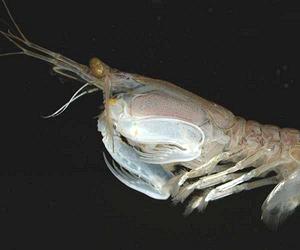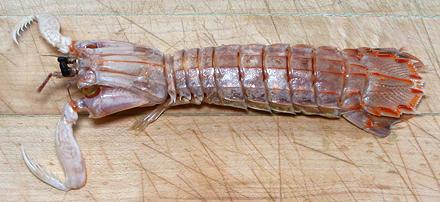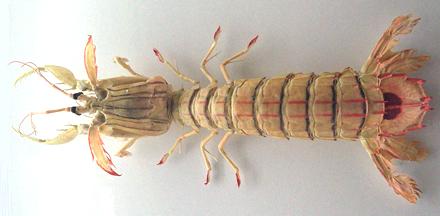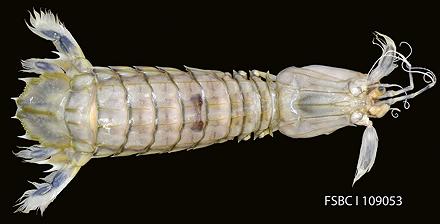 [Class Malacostraca; Subclass Hoplocarida; Order
Stomatopoda; Family Squillidae]
[Class Malacostraca; Subclass Hoplocarida; Order
Stomatopoda; Family Squillidae]
These assassins of the coastline are not even as closely related to regular shrimp as are crabs and lobsters, having branched from a common Malacostraca ancestor about 410 million years ago. While they are very common along all tropical and subtropical coastlines, and a few live in temperate regions, they are little known because they spend most of their time in deep burrows. Most only come out at night to prey upon other crustaceans, small fish, and anything else that moves. The largest on record was 18 inches long, from the Indian River of the southeastern United States.
The claws of these crustaceans are either clubs or spears. They kill their prey by projecting these claws at about 75 feet per second, and even if they miss, the prey may be stunned by the collapse of cavitation bubbles caused by the high velocity movement. They can cause painful injury to humans who are not careful in handling them. They cannot be kept in an aquarium because of their habit of killing and eating all the other creatures, even ones quite larger than themselves.
They have very complex eyes that can move independently, but they have depth perception in both eyes independent of each other. They also have up to 16 different color receptors, while humans have only three, and they can see light from deep ultraviolet to far red, as well as polarized light. We cannot even imagine how colorful the world looks to these critters.
Study of the unique properties of the Mantis Shrimp club claw is proceeding with the expectation it can help create a new generation of ultra strong composite structural materials and body armor. Photo by United States Government = Public Domain.
More on Shrimp & Prawns.
 [Shako (Japan); Be be, Tôm tít, Bàan Chai (Viet);
Lài niào xia, Laaih niu ha (Cantonese); Tatampal,
Hipong-dapa, Alupihang-dagat (Philippine); Oratosquilla oratoria]
[Shako (Japan); Be be, Tôm tít, Bàan Chai (Viet);
Lài niào xia, Laaih niu ha (Cantonese); Tatampal,
Hipong-dapa, Alupihang-dagat (Philippine); Oratosquilla oratoria]
This Mantis Shrimp is popular in East and Southeast Asia, growing to about 7.3 inches long, but the longest in the batch I purchased was 6-1/4 inches and weighed 1-1/4 ounces. The flesh tastes more like lobster than like shrimp, but there's very little of it to eat. This critter is mostly armor and legs, and the tail may be filled with orange eggs (which you eat along with the flesh.
 [Squilla mantis]
[Squilla mantis]
This is the only Mantis Shrimp caught commercially in the Mediterranean,
as it is by far the most common. Most are caught on the Italian side of
the Adriatic Sea, but they are also caught in the Ionian Sea, around
the island of Sardinia, along the coast of Catalonia, and the Balearic
Islands. It does, however, live also on the Atlantic coast, from the
Gulf of Cádz in southern Spain, on south to Angola, and around
the Canary Islands and Madeira. It is particularly abundant in areas
that have runoff from major rivers. These Mantis Shrimp can grow to
about 8 inches long.
Photo by Daderot contributed to the Public Domain.
 [Squilla empusa]
[Squilla empusa]
This Mantis Shrimp is native to the Western Atlantic, from Cape Cod
to the Gulf of Mexico. It is also reported from Brazil and the
Mediterranean. This crustation can grow to 12 inches long, possibly
longer. I know of no commercial harvest in North America.
Photo by FWC Fish and Wildlife Research Institute
distributed under Creative Commons
Attribution v2.0 Generic.